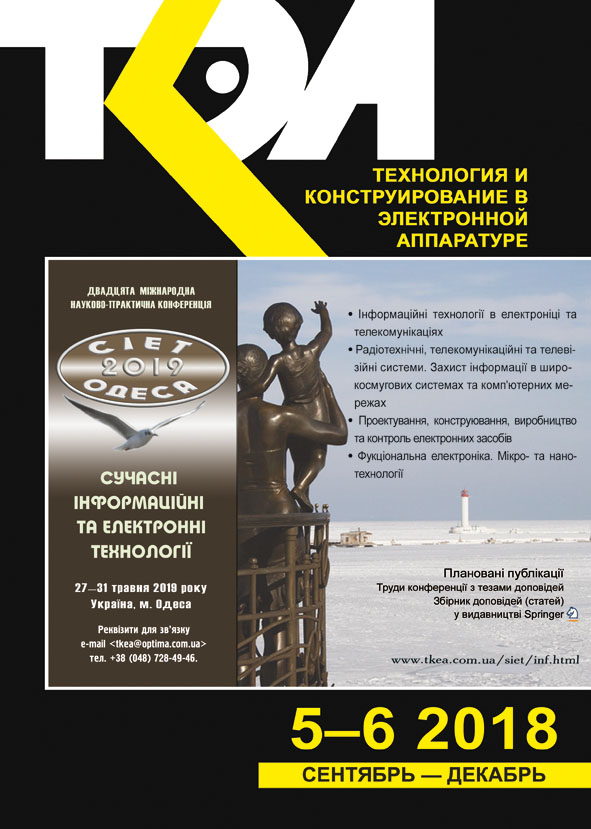Study on Cu2ZnSnSe4 crystals and heterojunctions on their basis
Abstract
The most promising materials for the solar radiation converters are such compounds as CdTe and Cu(In, Ga)Se2, CuIn(S, Se)2, CuGa(S, Se)2 solid solutions. However, the uneconomic nature of Cd, Te and the limited supply of In and Ga, as well as their high cost, force researchers to replace In and Ga with the more common elements of II and IV groups, namely Zn and Sn. Apart from that, researchers are now testing such new semiconductor compounds as ZnSnS4, Cu2ZnSnSe4, and solid solutions on their basis. These compounds have a band gap width (Eg ≈ 1.5 eV) close to optimal for the conversion of solar energy, a high light absorption coefficient (≈ 105cm–1), a long lifetime and a high mobility of charge carriers. Moreover, the interest in such semiconductor heterojunctions as TiO2/ZnSnS4, which have several advantages over homo-transitions, is steadily growing at present. The paper presents results studies of kinetic properties of Cu2ZnSnSe4 crystals. We fabricated n-TiO2/p-Cu2ZnSnSe4 anisotype heterojunctions, determined their main electrical parameters and built their energy diagram. The Cu2ZnSnSe4 crystals have p-type conductivity and the Hall coefficient practically independent of temperature. The temperature dependence of the electrical conductivity σ for Cu2ZnSnSe4 crystalsis metallic in character, i. e. σ decreases with increasing temperature, which is caused by a decrease in the mobility of the charge carriers with the growth of T. Thermoelectric power for the samples is positive, which also indicates the prevalence of p-type conductivity. In this study, the n-TiO2/p-Cu2ZnSnSe4 heterojunctions were produced by reactive magnetron sputtering of a thin TiO2 film on the Cu2ZnSnSe4 substrate. The energy diagram of the investigated n-TiO2/p-Cu2ZnSnSe4 anisotype heterojunctions was constructed in accordance with the Anderson model, without taking into account the surface electrical states and the dielectric layer, based on the values of the energy parameters of semiconductors determined experimentally and taken from literary sources. The authors have also investigated electrical properties of the heterojunctions: the value of the potential barrier was determined, the value of the series resistance and shunt resistance (respectively, Rs = 8 W and Rsh = 5.8 kW) at room temperature. The dominant mechanisms of current transfer were established: tunneling-recombination mechanism in the voltage range from 0 to 0.3 V, and over-barrier emission and tunneling with inverse displacement in the voltage range from 0.3 to 0.45 V.
References
Green M.A., Hishikawa Y., Warta W. et. al. Solar cell efficiency tables (version 50). Progress in Photovoltaics, 2017, pp. 668-676. http://dx.doi.org/10.1002/pip.2909
Wang W., Winkler M.T., Gunawan O. et al. Device characteristics of CZTSSe thin-film solar cells with 12.6% efficiency. Advanced Energy Materials, 2014, Vol. 4, pp. 1-5. http://dx.doi.org/10.1002/aenm.201301465
Solovan M. N., Mostovoi A. I., Bilichuk S. V. et al. Structural and optical properties of Cu2ZnSn(S,Se)4 films obtained by magnetron sputtering of a Cu2ZnSn alloy target. Physics of the Solid State, 2017, vol. 59 (8), pp. 1643-1647. https://doi.org/10.1134/S1063783417080261
Katagiri H., Jimbo K., Maw W.S. et al. Development of CZTS-based thin film solar cells. Thin Solid Films, 2009, vol. 517, no. 7, pp. 2455-2460. http://dx.doi.org/10.1016/j.tsf.2008.11.002
Kovaliuk T. T., Solovan M. N., Mostovyi A. I. et al. Research on Cu2ZnSnTe4 crystals and heterojunctions based on such crystals. Tekhnologiya i Konstruirovanie v Elektronnoi Apparature, 2015, no. 5–6, pp. 45-49. http://dx.doi.org/10.15222/TKEA2015.5-6.45 (Rus)
Nagaoka A., Miyake H., Taniyama T. et al. Effects of sodium on electrical properties in Cu2ZnSnS4 single crystal. Applied Physics Letter, 2014, vol. 104, pp. 152101. https://doi.org/10.1063/1.4871208
Shibuya T., Goto Y., Ramihara Y. From kasterite to stannite photovoltaics: Stability and band gaps of the Cu2(Zn,Fe)SnS4 alloy. Applied Physics Letters, 2014, vol. 104, pp. 0219121-0219124. http://dx.doi.org/10.1063/1.4862030
Alferov Zh. I. The history and future of semiconductor heterostructures. Semiconductors, 1998, vol. 32, iss. 1, pp. 1-14.
Fahrenbruch A.L., Bube R.H. Fundamentals of solar cells. Photovoltaic solar energy conversion, New York, 1983.
Mostovyi A.I., Brus V.V., Maryanchuk P.D. Charge transport mechanisms in anisotype n-TiO2/p-Si heterostructures. Semiconductors, 2013, vol. 47, pp. 799-803. https://doi.org/10.1134/S1063782613060171
Mebadi A., Houshmand M., Zandi M. H., Gorji N.E. Numerical analysis of TiO2/Cu2ZnSnS4 nanostructured PV using SCAPS-1D. Nano Hybrids, 2014, vol. 8, pp. 27-38. http://dx.doi.org/10.4028/www.scientific.net/NH.8.27
Houshmand M., Hamid Esmaili, Hossein M. et al. Degradation and device physics modeling of TiO2/CZTS ultrathin film photovoltaics. Materials Letters, 2015, vol. 157, pp. 123-126. https://doi.org/10.1016/j.matlet.2015.05.055
Wang Z., Brodusch N., Gauvina R., Demopoulos G. P. Nanoengineering of the Cu2ZnSnS4—TiO2 interface via atomic layer deposition of Al2O3 for high sensitivity photodetectors and solid state solar cells. Journal of Materials Chemistry A, 2018, vol. 24. http://dx.doi.org/10.1039/C8TA02966K
Cui H., Liu X., Hao X. et al. Improvement of Mo/Cu2ZnSnS4 interface for Cu2ZnSnS4 (CZTS) thin film solar cell application. Mater. Res. Soc. Symp. Proc., 2014, vol. 1638, pp. 1-7. https://doi.org/10.1557/opl.2014.208
Muska K., Kauk M., Grossberg M. et al. Influence of compositional deviations on the properties of Cu2ZnSnSe4 monograin powders. Energy Procedia, 2011, vol. 10, p p . 3 2 3 - 3 2 7 .
h t t p ://d x. d o i . o r g/1 0 . 1 0 1 6/j . e g y -pro.2011.10.198
Nam D., Kim J., Lee J.-U.et al. Polarized Raman spectroscopy of Cu-poor and Zn-rich single-crystal Cu2ZnSnS4. Applied Physics Letters, 2014, vol. 105, pp. 173903. http://dx.doi.org/0.1063/1.4900560
Sharma B.L., Purohit R.K. Semiconductor Heterojunctions. Pergamon Press, 1974.
Brus V. V., Ilashchuk M. I., Kovalyuk Z. D. et al. Mechanisms of charge transport in anisotype n-TiO2/p-CdTe heterojunctions. Semiconductors, 2011, vol. 45, pp. 1077. http://dx.doi.org//10.1134/S1063782611080045
Barkhouse D.A.R., Gunawan O., Gokmen T. et al. Device Characteristics of a 10.1% Hydrazine-processed Cu2ZnSn(Se,S)4 Solar Cell. Progress in Photovoltaics, 2012, vol. 20, pp. 6-11. https://doi.org/10.1002/pip.1160
Wang X., Xie Y., BateerB. et al. Selenization of Cu2ZnSnS4 enhanced the performance of dye-sensitized solar cells: improved zinc-site catalytic activity for I3. ACS Appl. Mater. Interfaces, 2017, vol. 9 (43), pp. 37662-37670. http://dx.doi.org/10.1021/acsami.7b09642
Solovan M.M., Gavaleshko N.M., Brus V.V. et al. Fabrication and investigation of photosensitive MoOx/n-CdTe heterojunctions. Semiconductor Science and Technology, 2016, vol. 31, 105006. http://dx.doi.org/10.1088/0268-1242/31/10/105006
Copyright (c) 2018 Kovaliuk T. T., Maistruk E. V., Solovan M. N., Koziarskyi I. P., Maryanchuk P. D.

This work is licensed under a Creative Commons Attribution 4.0 International License.

